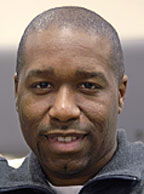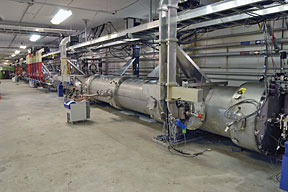| Research
|
|
|||||||||||||||||||||||
|
Check out symmetry—the
|
A "Tool" de ForceAmes Laboratory's Mark Gordon has devoted much of his professional career to making sure the right tools are available in GAMESS, the "toolbox" that he and thousands of researchers worldwide use on a daily basis to learn more about the goings-on of molecules and atoms—how they act, interact and react. GAMESS, or the General Atomic and Molecular Electronic Structure System, is a software suite chock-full of quantum chemistry codes—tools that take advantage of parallel, high-performance supercomputing systems to perform the very highest levels of theory required to help solve problems related to combustion, catalysis, photochemical energy conversion and the design of new fuels. Gordon cultivates the GAMESS software tools through mentoring graduate students and collaborating with his numerous professional colleagues. One of the GAMESS tools, the Fragment Molecular Orbital, or FMO method, was developed for GAMESS by Gordon's former graduate student, Dimitri Fedorov, and his colleague, Kazuo Kitaura, both of the Japanese National Computational Laboratory, AIST. The FMO method solves the problem of doing quantum chemistry on a large molecule, such as a polymer, enzyme or protein, by "chopping" it into small pieces, doing calculations on those pieces, and then uniting the fragments to make the larger system. To enhance the FMO tool, Gordon led a team that included his postdoctoral researcher, Hui Li; former graduate student, Jan Jensen, now at the University of Iowa ; Fedorov; and Kitaura in developing a method of modeling the activity of molecules in solution. They created the new GAMESS tool by interfacing the Polarizable Continuum Model, PCM, with the FMO method. "If you're interested in polymers and enzymes, whatever they do, they do in solution," says Gordon. "That means just doing FMO calculations is not enough—you need to get the solvent in there." With Gordon's guidance, two of his former graduate students, Ivana Adamovic and Heather Netzloff, along with Li, developed new GAMESS tools to model dispersion and charge transfer interactions. Adamovic, now at the Harvard School of Health in Boston , developed the model potential that handles the fleeting molecular ebb and flow associated with dispersion forces. Her contribution allows the Gordon group to do calculations on DNA base pairs, and they are currently working with the Iowa State University chemical engineering department to study the aggregation of polymers, such as latex. Li, who will be an assistant professor next fall at the University of Nebraska , and Netzloff, now at Australian National University , respectively created a molecular dynamics code to address the interactions that occur between ions and optimized the code to take advantage of parallel computers. The addition of the charge transfer code to GAMESS is of particular importance to Gordon who is interested in ionic liquids in the design of high-energy fuels—products that bring together positively and negatively charged species. "You can't simulate those relationships adequately unless you have something that accounts for the charge transfer interactions, and we now have that capability in GAMESS," says Gordon. GAMESS is distributed at no cost to users by accessing www.msg.ameslab.gov and signing a license agreement. Submitted by DOE's Ames Laboratory |


